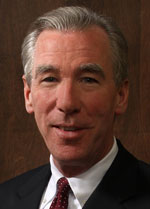At the Catholic University of America, where I serve as president, we have been working on some revisions to our code of student conduct. We’re finding that it’s challenging because we need to send students two different messages about sex that can at times clash awkwardly.
One pertains to sexual abuse — rape, sexual assault, sexual battery. The message here is fairly obvious. It is both a crime and a sin against justice and charity. Its distinguishing mark is the element of coercion — of forcing sex on an unwilling victim.
Sexual abuse is not only forbidden by state criminal law. It is also addressed by federal laws that apply to colleges — Title IX, the Violence Against Women Act, and the Clery Act (which requires colleges to report sex offenses near campus).
College student conduct codes will usually tell students that the difference between sex and sexual abuse is the element of consent. And they will use a formula something like this to define consent: “Consent is informed, freely given, mutually understandable words or actions that indicate a willingness to participate in sexual activity.”
But that’s not the end of the story from a Catholic perspective. Consensual sex between students matters, too. It’s not a crime (fortunately), but it is a sin against chastity when it takes place outside of marriage.
Chastity is an unfashionable virtue nowadays, but the idea is not hard to understand. Casual sex is harmful even if there is no coercion. It plays at love for sport. It makes promises that the players don’t intend to keep. It insults the dignity of the other person by treating him or her as a sex toy rather than a child of God. It divorces sex from the creation of new life and the unity of a family.
At The Catholic University of America, as at other universities, there should be exact and uncompromising justice for the crime of sexual abuse. At the same time, we want to steer our students toward something better than merely avoiding violence. We want them to embrace virtue and avoid vice.
Risk managers (accountants and lawyers) want us to be very clear with our students about what counts as sexual abuse: “Make sure your partner is a willing participant in any sexual activity. Get consent for every move you make.” If we’re not explicit about this, they say, we may be guilty under Title IX of creating a hostile environment, and risk losing federal funds.
That makes some sense. But if we do follow the accountants’ and lawyers’ advice, it’s a bit awkward to turn around then and say, “But wait — that sexual activity we told you to get consent for? You should not be doing it at all.”
There is no logical inconsistency between the goals of preventing sexual violence and promoting chastity. The two are actually quite harmonious. The awkwardness in explaining this arises because our culture doesn’t want to hear the message it needs. It wants to prevent violence while preserving promiscuity. It is forbidden to consider that for some subset of the population, the latter can lead to the former.
Casual sex is a disordered activity. If you engage in it, it creates terrible habits in you and degrades your partner. For some, it will also create a sense of entitlement to sex without commitment. And this sense of entitlement is quite dangerous. To discuss such topics as date rape without providing this context is to play a game of pretend.
Like all virtues, chastity produces good habits in those who practice it. The promise to avoid and prevent sexual violence is one we can all keep. We can keep it more easily if we practice and respect this old-fashioned virtue.
PREVIOUS: Flood of bad news forces a choice to run away or confront it
NEXT: Decentralization without communication will never work




Share this story